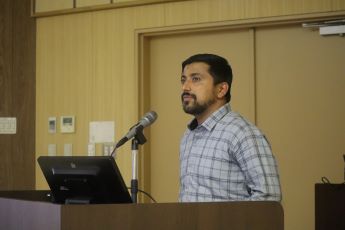- Home
- プログラム生/Ally生の活動報告
- 第13回 Student Monthly Progressを開催しました
第13回 Student Monthly Progressを開催しました
6月28日 (金)、第13回 Student Monthly Progressを開催しました。
4名の大学院生が自身の研究内容について発表を行いました。
【発表者】
1. LEE Seungyeon:Laboratory of Veterinary Internal Medicine
<Automatic 3d segmentation of liver in CT images with a deep learning model in dogs>
2. TSUKADA Anju:Laboratory of Biochemistry
<Administration of antibiotics during late lactation suppresses beige adipocyte induction in preweaning mice>
3. SEOK Bong Soo:Laboratory of Biochemistry
<Acute Food Intake Induced Thermogenesis in Brown Adipose Tissue in Mice>
4. BARAL Rishi:Laboratory of Wildlife Biology and Medicine
<Predicting the potential habitat of bears under a changing climate in Nepal>
【座長】
BELLO Taiwo Kamar-deen:Laboratory of Theriogenology
TIYAMANEE Wisa:Laboratory of Infectious Diseases

❖座長レポート❖
Four students introduced their research during the June Student Monthly Progress Meeting.
LEE Seungyeon's research focused on medical image segmentation by developing a deep-learning model for automatic liver and tumor segmentation in canine CT scans, thereby enhancing diagnostic accuracy and efficiency. She collected CT scans, medical records of the dogs, including data on age, sex, neutering status, body weight, and laboratory examination results at Hokkaido University Veterinary Teaching. She then employed the use of various deep learning architectures (CNN, U-Net, U-Net++, FPN) and used image augmentation to create a realistic dataset. She also used performance metrics such as the Dice Coefficient and Hausdorff Distance to evaluate the model. The study is still ongoing, and it is expected to demonstrate the model's ability to enhance surgical/radiation planning, research, and education by providing accurate and reliable liverband tumor segmentations.

TSUKADA Anju aimed to examine the specific timeframe of maternal antibiotic treatment that suppresses the beige adipocytes induction in preweaning pups. In her study, C57BL/6J female mice were given drinking water with antibiotics during the first half of lactation, from birth to day 10 (1st half group), or during the second half of lactation, from day 10 to day 20 (2nd half group), and WAT from 20-day-old pups was analyzed. Beige adipocytes induction was assessed by RT-qPCR, western blotting, and histology. Her results showed that Ucp1 gene expression and UCP1 protein expression were significantly suppressed in the 2nd half group compared to the control and the 1st half group. Furthermore, histological analysis showed the decrease in the number of beige adipocytes. Her conclusion from these findings was that the antibiotic administration during late lactation period suppressed the beige adipocyte induction in pups, suggesting that gut microbiota formed during this period may be related to the induction of beige adipocytes.

In his study, SEOK Bong Soo investigated the effect of acute intake of high-fat diet (HFD)on BAT thermogenesis in mice. Six-week-old C57BL/6 male mice were implanted with E-mitters which monitors temperature and locomotor. After one week of the recovery period, mice were fasted overnight and then fed with a high-fat diet (HFD) for an hour. Physiological changes such as oxygen consumption rate (VO2) and temperature were measured via indirect calorimetry and E-mitter to identify DIT. The gene expression of Uncoupling protein 1 (Ucp1), the index of the activation of BAT thermogenesis, was measured in BAT as a molecular change to identify the involvement of BAT in DIT. The result from his study showed that compared to fasted group, 1hr refed group showed higher VO2 and temperature after food intake. The Ucp1 expression in BAT of the refed group significantly increased at 3hr postprandial compared to the fasted group. He concluded his presentation by stating that acute intake of HFD was sufficient to induce DIT which was comprised of BAT thermogenesis.

The last presenter was BARAL Rishi, who investigated prediction of climatically suitable habitats for sloth bears, Himalayan black bears, and brown bears in Nepal using climate and species distribution models. Secondly, identifying habitat overlapping among these bear species under different climate scenarios. In his study, he collected occurrence data for brown bears, Asiatic black bears, and sloth bears from various sources, filtering it to retain one record per 1 km2 grid. Using 19 bioclimatic and 3 topographic variables from the WorldClim database, he predicted species distributions for present and future scenarios (SSP2-4.5 for 2050 and 2070). Species distribution models (SDMs) were created using Random Forest (RF), Maximum Entropy (MaxEnt), and Generalized Linear Models (GLM), chosen for their high mean True Skill Statistic (TSS) values. The models were then trained on 80% of the data, with 20% reserved for testing, and evaluated using AUC and TSS metrics. He further stated that an ensemble model, incorporating high-performing algorithms, was used to analyze habitat suitability, providing crucial insights for conservation planning. From the result presented, he said currently, suitable habitats cover 10,971.75 km2 for sloth bears, 29,470.75 km2 for Asiatic black bears, and 6,152.97 km2 for brown bears. The future projections under the SSP2-4.5 scenario indicate substantial habitat reductions by 2050 and 2070, especially for brown bears, with potential habitat losses of 68.41% and 82.20%, respectively. Notably, suitable habitat within protected areas is expected to increase for brown and Asiatic black bears but decrease for sloth bears. The overlap among the species' habitats is minimal, with some overlap between brown and Asiatic black bears in Annapurna and Manaslu Conservation areas, and between sloth bears and black bears in Bardia National Park and Siwalik hills. In conclusion, he stated climate change is expected to reduce and shift the habitats of sloth bears, Asiatic black bears, and brown bears in Nepal.






